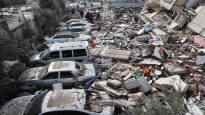The devastation in Turkey and Syria shocked not only anyone who saw the pictures of the destruction, but also professionals in the construction industry.
Including a US TV channel CNN (you will switch to another service) interviewed by a professor of earthquake engineering Mustafa Erdik.
What is disturbing in the pictures of the disaster area is that the earthquake treated buildings standing next to each other in different ways in many places.
The pictures show how the neighboring house next to the house that remained standing may have crumbled into concrete rubble.
Professor of structural design and technical mechanics at the University of Oulu Antti H. Niemi tells four possible reasons why some houses stood and others did not.
1. Lack of steel
– Concrete is fragile as a building material. In order for a tall building to withstand an earthquake, it must have sufficient toughness and deformability, Niemi explains.
According to Nieme, these properties are obtained when steel is used in concrete structures.
– Steel is tough, says Niemi.
Niemi says that by using steel, the building can withstand the tensile stresses caused by earthquakes.
– The role of steel is emphasized especially in the vertical pillars of buildings, because they are critical parts, says Niemi.
However, installing steel in structures is challenging and requires careful planning, especially in tall buildings.
2. Errors and deficiencies in planning
Individual mistakes in the design and construction of buildings can also explain the extent of the damage.
According to Niemi, the aim is to design the buildings so that under no circumstances would they collapse to the ground.
In Japan, for example, construction is well developed and buildings are designed to be as flexible as possible.
– In Turkey, sufficient deformability had not been ensured, so in practice the design has not been good enough, says Niemi.
Mustafa Erdik, interviewed by CNN, also considers it serious that the buildings were planned so poorly.
3. Age of buildings
Niemi speculates that older reinforced concrete buildings may not have been originally designed to withstand strong earthquakes.
– Earthquake measurements, regulations and standards of construction in Turkey have only been significantly reformed since the 21st century, says Niemi.
According to Niemi, significant reforms were made only in 2007 and a second time in 2018.
– You can roughly say that the older buildings have collapsed, although there are some indications of the collapse of newer buildings as well, Niemi estimates.
In newer buildings, earthquake measurements should have already been taken into account.
4. Lack of construction supervision
The fact that newer buildings also collapsed may indicate a lack of supervision, corruption or circumvention of the rules.
– The question arises as to whether the construction was sufficiently supervised or whether the instructions were followed, Niemi reflects.
Erdik also says that the regulations have not been sufficiently followed.
Turkey has guided planning through laws and administrative processes, but there is still room for improvement.
The regulations have not always been followed because the construction would have been more expensive and it would have limited the growth of the Turkish economy.
Construction quality developed in the 21st century
According to Niemi, the quality of construction in Turkey has improved over the years.
Before 1999, construction was not very regulated, and the threat of earthquakes was not taken into account too much.
In 1999, an earthquake occurred in Turkey, killing 14,000 people. Since then, Turkey has tightened construction requirements.
The actual functional earthquake design of buildings is a new thing in the field, says Niemi.
– They were not common before the 2000s, and they are not very common even today.
According to Niemi, buildings that meet current requirements should withstand earthquakes of up to magnitude eight.
However, how deep the earthquake occurs also has a significant effect. So the intensity of the earthquake does not tell the whole truth.
Turks dissatisfied with construction quality and state aid
The Turks have harshly criticized the construction. Weak building control and corruption have eroded people’s faith in sustainable construction in the 21st century, he says CNBC (switch to another service).
of HS (you switch to another service) According to Kerem Tuncay, a former architect who lives in Istanbul, there was corruption in construction in the late 2000s.
Turkey has begun investigating the builders of the collapsed buildings and ordered their arrest.
Turks have also criticized the state’s slow response to the crisis.
Two weeks have passed since the earthquakes
The recent earthquakes in Turkey and Syria are among the most destructive in the 21st century.
Only the earthquakes in Pakistan, China, Indonesia and Haiti have been more destructive in terms of the number of victims and injured.
The highest number of victims was in the earthquakes in Haiti in 2010, when more than 500,000 people died and were injured.
Due to the earthquake in Indonesia in 2004 and the resulting tsunami, more than 165,000 people died. The exact number of injured is unknown.
The total number of dead in Turkey and Syria is currently reported to be over 46,000.
According to the UN estimate, the number of dead will rise to more than 50,000. The number of injured is over 75,000, but the numbers will rise.
The World Health Organization (WHO) estimates that earthquakes can affect the lives of more than 23 million people.
You can discuss the topic until Wednesday, February 22 at 11 p.m.
